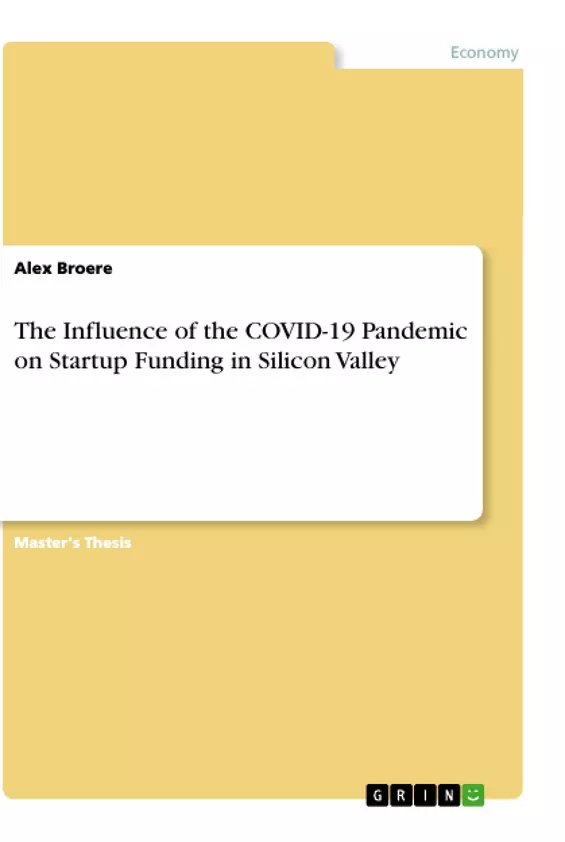Silicon Valley is home to 6 out of the 10 most valuable companies in the world and is considered to be the worldwide leader in venture capital. However, at the same time, the area faces the highest living costs and business expenses in the nation. Reports suggest that people and businesses have been leaving the area due to the COVID-19 pandemic.
This study takes a time series analysis approach in order to determine whether there has been a structural change in Silicon Valley’s startup funding activity during the COVID-19 pandemic. A dataset of 13,350 funding rounds in Silicon Valley from 2016 to 2020 has been collected from Crunchbase. The time series analysis is conducted in R using the Strucchange package and Chow tests. Results suggest that no structural change has occurred in the total startup funding activity or in the proportion of early-stage investments during the COVID-19 pandemic.
Inhaltsverzeichnis (Table of Contents)
- Abstract
- Introduction
- Literature Review
- Data and Method
- Results
- Discussion
- Conclusion
- Reference List
- Appendix A
- Appendix B
- Appendix C
- Appendix D
- Appendix E
- Appendix F
Zielsetzung und Themenschwerpunkte (Objectives and Key Themes)
This thesis investigates the influence of the COVID-19 pandemic on startup funding activity in Silicon Valley. It aims to determine whether there has been a structural change in venture capital activity in the region during the pandemic. The study uses a time series analysis approach to analyze data from Crunchbase, a large public database of companies, for the period between 2016 and 2020.
- The impact of the COVID-19 pandemic on Silicon Valley's startup funding activity.
- The role of venture capital in startup success.
- The challenges faced by startups in Silicon Valley, including high living costs and business expenses.
- The potential for changes in venture capital activity and the impact on startups.
- The importance of entrepreneurial ecosystems for startup growth and success.
Zusammenfassung der Kapitel (Chapter Summaries)
- Introduction: This chapter introduces the concept of startup ecosystems and their importance in fostering innovation and growth. It focuses on Silicon Valley as a leading example, highlighting its role as a hub for venture capital and successful startups. The chapter also discusses the challenges faced by Silicon Valley, including high living costs and business expenses, and raises the question of whether the region remains attractive to startups in the wake of the COVID-19 pandemic.
- Literature Review: This chapter reviews the existing literature on startup ecosystems, venture capital, and the impact of pandemics on businesses. It identifies key factors that contribute to successful startup ecosystems and explores the role of venture capital in supporting startup growth. The chapter also examines previous research on the impact of economic crises on entrepreneurial activity.
- Data and Method: This chapter describes the data sources and methodologies used in the study. The chapter explains the selection of Crunchbase as the primary data source and details the time series analysis approach used to examine changes in venture capital activity in Silicon Valley.
- Results: This chapter presents the results of the time series analysis, focusing on the overall trends in startup funding activity in Silicon Valley and the potential impact of the COVID-19 pandemic. The chapter examines the data for any evidence of structural changes in venture capital activity.
Schlüsselwörter (Keywords)
The primary focus of this research is on the impact of the COVID-19 pandemic on startup funding activity in Silicon Valley. This includes exploring themes such as venture capital, entrepreneurial ecosystems, startup success, and time series analysis. The research utilizes a large public database, Crunchbase, to gather data on startup funding rounds. Key concepts explored in the study include structural change, economic impact, and the role of funding in startup growth. The study also considers the challenges faced by startups, including high living costs and business expenses, and explores the potential for changes in the Silicon Valley ecosystem due to the pandemic.
- Citation du texte
- Alex Broere (Auteur), 2021, The Influence of the COVID-19 Pandemic on Startup Funding in Silicon Valley, Munich, GRIN Verlag, https://www.grin.com/document/1146548



